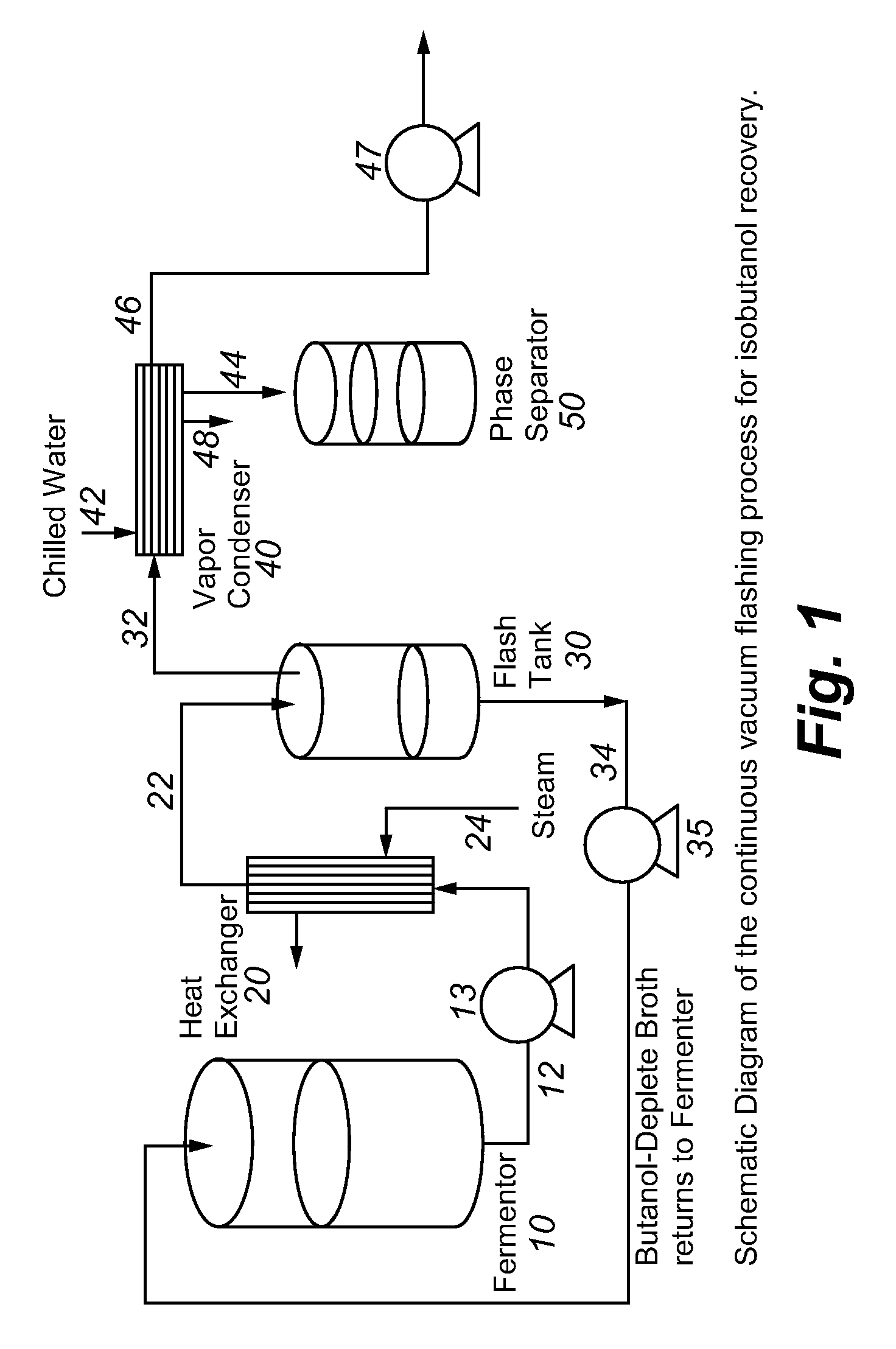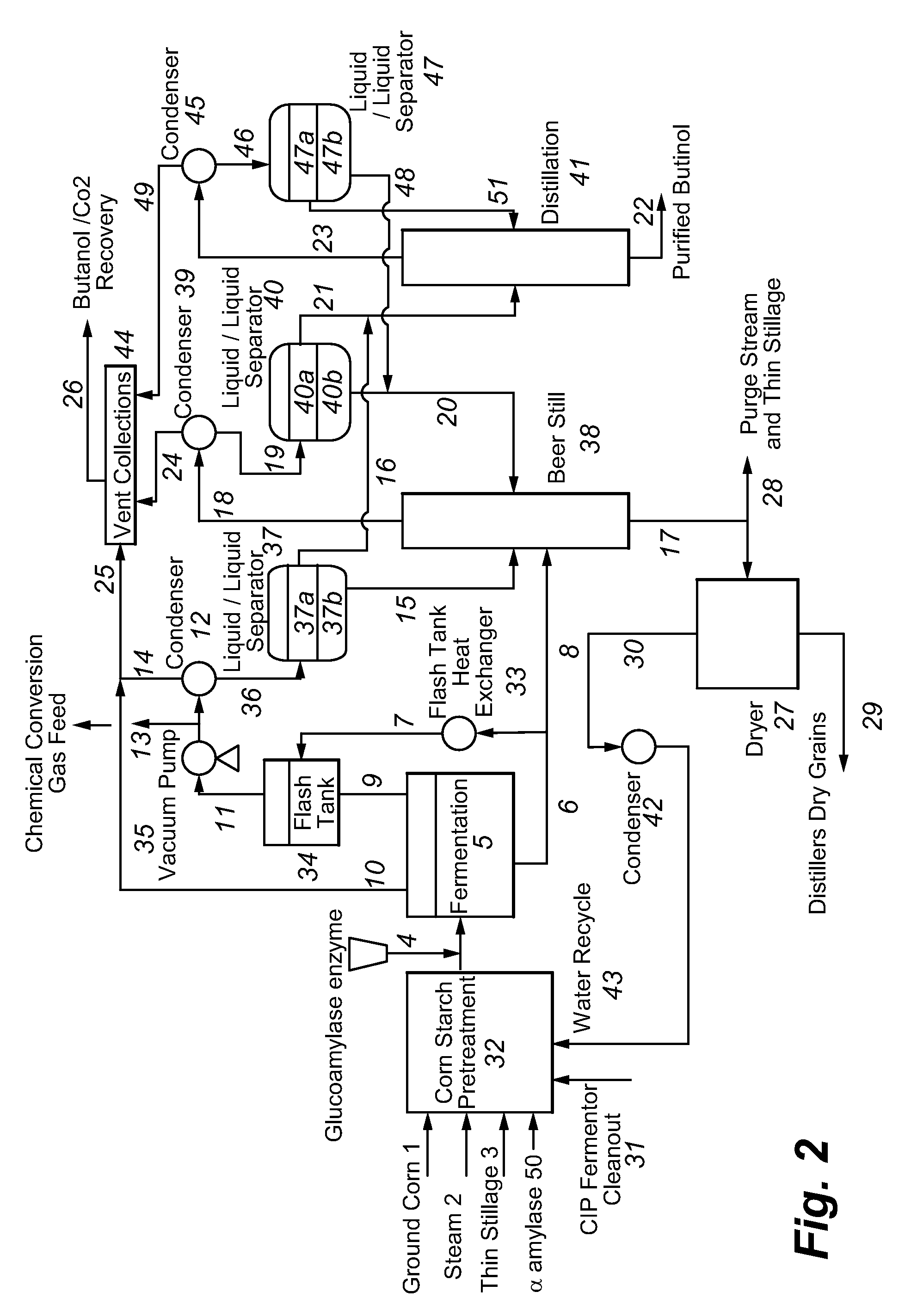Recovery of higher alcohols from dilute aqueous solutions
a technology of aqueous solution and a recovery method, which is applied in the preparation of oxygen-containing compounds, oxygen-containing compounds, and oxygen-containing compounds, etc., can solve the problems of increasing the cost of biofuels, increasing the demand for alternative fuels, and limited specialty applications and niche markets of biofuels that cannot compete in cost with petroleum-derived fuels. , to achieve the effect of increasing the activity of c3-c6 alcohol
- Summary
- Abstract
- Description
- Claims
- Application Information
AI Technical Summary
Benefits of technology
Problems solved by technology
Method used
Image
Examples
example 1
Enrichment of C3-C6 Alcohols from Aqueous Solutions Using Solvents
[0139]This example illustrates the enrichment of C3-C6 alcohols, such as propanol (PrOH), butanol (BuOH), isobutanol (i-BuOH) and pentanol (PenOH), from aqueous solutions using various solvents.
[0140]Several aqueous solutions were prepared for each alcohol, differing in their alcohol concentrations, all of which were sub-saturated. Each of those aqueous solutions was mixed with a solvent, such as butylacetate, tributylphosphate, decanol, 2-hepanone or octane. The phase ratio between the aqueous solution and the solvent differed from one case to the other. Mixing was continued until equilibrium was reached. At equilibrium, phase separation could be observed forming an upper, alcohol-rich phase (light phase) and a lower, alcohol-lean phase (heavy phase). Both phases were analyzed for alcohol and water content. The alcohol concentrations were analyzed by high pressure liquid chromatography (HPLC) at 25° C. using a YMC-Pa...
example 2
Extraction of Isobutanol from Aqueous Solutions Using Solvents
[0151]This example illustrates the efficiency of the enrichment of isobutanol from sub-saturated aqueous solutions using various solvents. Table 2 summarizes the results of various isobutanol enrichment experiments. Isobutanol was extracted from aqueous solutions of various starting concentrations. Several solvents were used to carry out a single step extraction at 25° C. In addition, the solvent phase to aqueous phase ratio was varied. The isobutanol concentration in the solvent was measured for each experiment and the extraction yield was calculated for each experiment by dividing the alcohol amount in the solvent by the initial alcohol amount in the aqueous solution.
[0152]
TABLE 2Enrichment of i-BuOH from aqueous solutions of various concentrationswith several extractants: butyl acetate (BuAc), decanol (DeOH),tri-butyl-phosphate (TBP) and 2-heptanone.InitialFinali-BuOHi-BuOHi-BuOHconc.Solvent / conc.conc.(Wt %) inaqueous(...
example 3
Enrichment of C3-C6 Alcohols from Aqueous Solutions Using Gasoline
[0155]This example illustrates the enrichment of C3-C6 alcohols from aqueous solutions by contacting with gasoline.
[0156]Aqueous solutions of C3-C6 alcohols, including propanol (PrOH), butanol (BuOH), isobutanol (i-BuOH) and pentanol (PenOH), were prepared and mixed with gasoline until equilibrium was reached. The gasoline used was commercial grade with a 95 octane rating. At equilibrium, the mixture formed an upper alcohol rich phase (light phase) and a lower alcohol lean phase (heavy phase). Both phases were analyzed for alcohol and water content. The distribution coefficient of the alcohol was calculated for each experiment by dividing the alcohol concentration in the light phase by the concentration in the heavy phase. Similarly, the distribution coefficient for water was calculated by dividing the water concentration in the light phase by the water concentration in the heavy phase. The enrichment factor was calcu...
PUM
| Property | Measurement | Unit |
|---|---|---|
| temperature | aaaaa | aaaaa |
| temperature | aaaaa | aaaaa |
| pressure | aaaaa | aaaaa |
Abstract
Description
Claims
Application Information
 Login to View More
Login to View More - R&D
- Intellectual Property
- Life Sciences
- Materials
- Tech Scout
- Unparalleled Data Quality
- Higher Quality Content
- 60% Fewer Hallucinations
Browse by: Latest US Patents, China's latest patents, Technical Efficacy Thesaurus, Application Domain, Technology Topic, Popular Technical Reports.
© 2025 PatSnap. All rights reserved.Legal|Privacy policy|Modern Slavery Act Transparency Statement|Sitemap|About US| Contact US: help@patsnap.com


